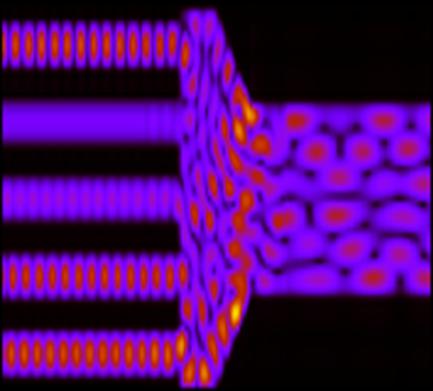当前位置:
X-MOL 学术
›
Phys. Status Solidi A
›
论文详情
Our official English website, www.x-mol.net, welcomes your feedback! (Note: you will need to create a separate account there.)
A Ballistic Transport Model for an Artificial Neuron
Physica Status Solidi (A) - Applications and Materials Science ( IF 2 ) Pub Date : 2020-04-16 , DOI: 10.1002/pssa.201900936 George Alexandru Nemnes 1, 2, 3 , Daniela Dragoman 1, 4
Physica Status Solidi (A) - Applications and Materials Science ( IF 2 ) Pub Date : 2020-04-16 , DOI: 10.1002/pssa.201900936 George Alexandru Nemnes 1, 2, 3 , Daniela Dragoman 1, 4
Affiliation

|
A model for an artificial neuron (AN) is introduced which is based on ballistic transport in a multiterminal device. Unlike standard configurations, the proposed design embeds the synaptic weights into the active region, thus significantly reducing the complexity of the input terminals. This is achieved by defining the basic elements of the ballistic AN as follows: the input values are set by the incoming wavefunctions amplitudes, whereas the weights correspond to the scattering matrix elements. Furthermore, the output value of the activation function of the AN is given by the transmission function. By tuning the gate voltage, the scattering potential and, consequently, the weights are changed so that the value of the transmission function gets closer to the target output, which is essential in the training process of artificial neural networks. Thus, the modus operandi of a ballistic AN is provided.
中文翻译:

人工神经元的弹道运输模型
引入了基于多端设备中弹道运输的人工神经元(AN)模型。与标准配置不同,建议的设计将突触权重嵌入到活动区域中,从而显着降低了输入端子的复杂性。这是通过如下定义弹道AN的基本元素来实现的:输入值由传入波函数振幅设置,而权重对应于散射矩阵元素。此外,AN的激活函数的输出值由传递函数给出。通过调整栅极电压,可以改变散射电位,从而改变权重,从而使传递函数的值更接近目标输出,这在人工神经网络的训练过程中至关重要。提供了弹道AN的操作方法。
更新日期:2020-04-16
中文翻译:

人工神经元的弹道运输模型
引入了基于多端设备中弹道运输的人工神经元(AN)模型。与标准配置不同,建议的设计将突触权重嵌入到活动区域中,从而显着降低了输入端子的复杂性。这是通过如下定义弹道AN的基本元素来实现的:输入值由传入波函数振幅设置,而权重对应于散射矩阵元素。此外,AN的激活函数的输出值由传递函数给出。通过调整栅极电压,可以改变散射电位,从而改变权重,从而使传递函数的值更接近目标输出,这在人工神经网络的训练过程中至关重要。提供了弹道AN的操作方法。



























 京公网安备 11010802027423号
京公网安备 11010802027423号